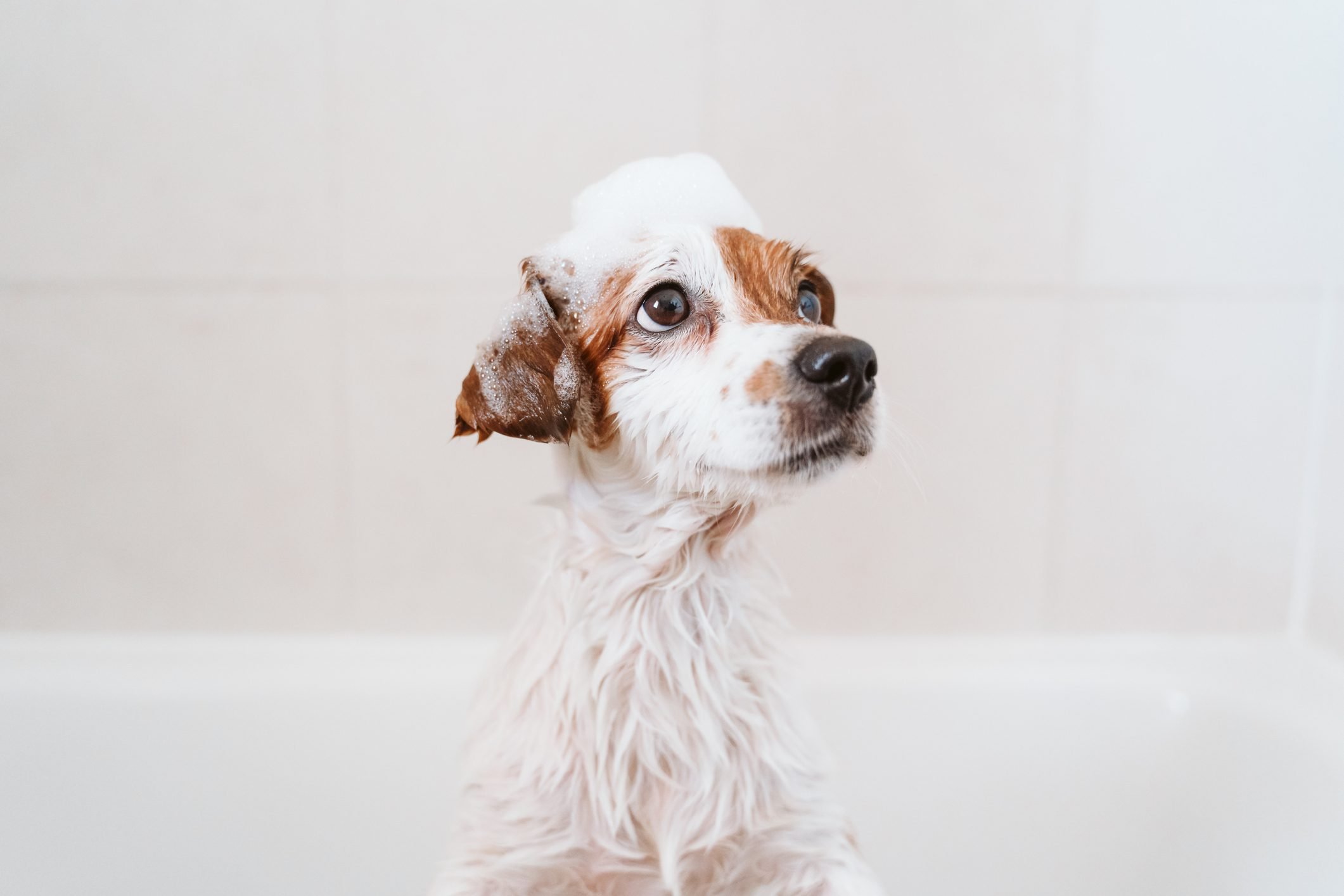Learn the secrets to dog bathing success! Find out how often to bathe your pup, tips to make it enjoyable, and why over-bathing can harm their health.

How Often Should You Bathe Your Dog?

You should only bathe your dog when necessary. I rarely give any of my dogs a bath unless they’re having widespread skin issues like allergic dermatitis, or unless they’ve rolled in something nasty. (My young whippet, Phoebe, is the biggest culprit there. Fox poop, anyone?)
Bathing your dog too frequently strips their skin of those all-important oils and can upset the pH balance, leading to dry, flaky, irritated skin.
If you struggle to bathe your dog at home, I’ve got some tips to make bath time at least tolerable for all involved.
On This Page
How Often Should You Bathe Your Dog?
Not unless they need it. Factors like your dog’s size, whether they spend most of their time indoors or outdoors, and the type of fur can all impact the ideal bathing frequency.
Why you shouldn’t bathe your dog too often
Over-bathing can have several negative effects on your dog’s health and well-being:
- Stripping natural oils: These keep your dog’s coat healthy, shiny and moisturized. Bathing them too frequently strips these oils away, leading to dry, itchy skin and a dull, brittle coat.
- Disrupting the skin’s pH balance: A dog’s skin has a delicate pH balance that protects against irritants and infections. Using shampoo too often can disrupt this balance, making your dog more susceptible to skin issues and allergies.
- Increased risk of infections: Over-bathing can cause your dog’s skin to become dry and cracked, making it more vulnerable to bacterial and fungal infections.
- Stress and anxiety: Some dogs find baths stressful. Forcing them to endure this experience too often can lead to increased anxiety and potential behavioral problems.
Why the type of dog matters
My two guys love getting dirty. On those days when they’re just too messy to wipe down, a bath (or shower, in our case) is essential. But not everyone has a dirt-loving pooch.
My friend has a dog who looks at my dogs in disgust when they go tearing off through the mud. There’s no way she wants to get her little self dirty, and she really hates swimming. She prefers chasing her ball across the grass. So she needs bathing less often.
Long fur vs. short fur
Short-coated dogs tend to need less grooming and bathing than long-coated dogs because there’s just less fur for dirt to stick to.
My 20-pound terrier mix, Oscar, is rough-coated, so when he gets dirty and wet, there’s a lot of dirty and wet fur. My whippet, on the other hand, has short, thin fur, so she’s much easier to wipe down with some decent doggy wipes.
Do Dogs Like Baths?
Yes and no. Some dogs love the watery sensation, while others fear it. Showers can be a good alternative for dogs that dislike baths, since the gentle stream of water can be less overwhelming.
The key is making bath time fun and enjoyable for your dog, with a slow, positive introduction. Use toys or lick mats smeared with their favorite spreadable treats stuck to the wall. These lick mats have suction cups on the back. Any happy, fun thing to make bath time better works.
Why do dogs do the zoomies after a bath?
Every dog I’ve ever had ran around the house like a lunatic after a bath, rolling, rubbing against furniture, and just generally being nutty. But why? Well, there are a few reasons:
- Relief: The exuberant mad dash is partly relief the bath is over. They’re expressing their joy with a burst of energy.
- Instinct: Dogs are smart, and they know the fastest ways to dry off. So they rub on dry, soft surfaces like your furniture, and run around to generate air movement. It’s clever, and they’re right. Heat, air and something absorbent all help them dry off quickly.
- They want their scent back: We tend to think orange peel and sweet jasmine smells are desirable, but our dogs don’t agree. They want to smell like themselves, or possibly the stinky deer poop or the dead fish they rolled in that led to them needing a bath to begin with. So they zoom around and roll on stuff to lose the shampoo smell and get back to smelling like their themselves as fast as possible.
Tips on How To Bathe a Dog
If your dog is reluctant about bath time, there are ways to help them tolerate it better. Don’t yell at them, force them in or punish them. New things are scary to a dog. Be patient. And kind.
- Start slow: Ideally, introduce your dog to the bath or shower gradually, and long before you actually need to give them a bath.
- Choose the right shampoo: Use a dog-specific shampoo that’s gentle on their skin and pH-balanced.
- Go DIY: If you’re handy, you could even try making a dog wash station
- Brush their fur beforehand: This removes any loose hair and tangles, making bathing easier and more efficient.
- Use lukewarm water: Avoid hot water, which can be uncomfortable cause skin irritation.
- Be gentle: Massage the shampoo into your dog’s fur with gentle, circular motions. Make sure to rinse thoroughly to remove all soap residue.
- Reward your dog: Give them lots of praise while you work, tell them they’re amazing and give them lots of gentle, rewarding physical attention. And don’t forget the lick mat covered in their favorite spreadable treat, like yogurt or cream cheese.




















